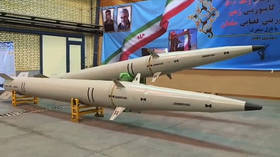Weighs less & packs more range: Iran unveils new ballistic missile with composite-built engine (VIDEO)

Tehran has rolled out a new advanced ballistic missile featuring a composite-built engine. The new missile to be two times lighter than earlier models, but has greater operational range.
The new projectile was unveiled by the chief of the elite Islamic Revolution Guards Corps (IRGC), Major General Hossein Salami, on Sunday. Video released by the Iranian state media shows two new missiles on display during the event, as well as footage of a test launch.
The missile, dubbed Ra’d-500, is said to be packed with engines, made largely of composite materials. It has significantly lightened the build and the new munition is two times lighter than an earlier model — Fateh-110 missile. The engine, containing carbon fibers, is said to be able to withstand pressures as high as 100 Bar and a temperature of up to 3,000 degrees Celsius.
Usage of composites has also contributed to an increase in operational range, with Ra’d-500 reaching at least 500 km — compared to some 300 km of the older munition.
Apart from the missile, Salami also unveiled an engine, designed for use in upper stages of light spacecraft. The engine is built utilizing the same composite materials as its military counterpart and it is capable of thrust vectoring, that is essential in fine tuning the heading of a spacecraft in orbit.
Later in the day, Iran also launched a satellite dubbed ‘Zafar’ — Persian for ‘Victory.’ Zafar is said to be a scientific satellite, supposed to collect imagery of the Earth, that comes handy in studying various natural occurrences, namely earthquakes.
Also on rt.com ‘We turned their pressure into opportunity’: Supreme Leader hails Iranian Air Force built up despite US sanctionsIts launch, however, did not exactly turn out to be victorious — the spacecraft blasted off successfully, yet failed to gain enough speed to actually reach orbit. Still, it managed to transfer some valuable telemetry that is expected to make further launches more successful, state media reported.
Think your friends would be interested? Share this story!














